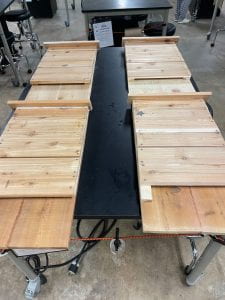About Me
Hi! I am Esther Fahel, a Mechanical Engineering student at Brown College. In high school, I developed a love for physics and its ability to explain the mysteries around me. My physics teacher emphasized that the subject is, “impossible until you understand it, then it becomes trivial,” a quote from Ernest Rutherford. I fell in love with problem-solving in all STEM subjects as my vehicle for making the impossible trivial. Now I aspire to work in the renewable energy industry, harnessing physical laws to innovate sustainable solutions. My first design project was making a wrist orthosis for a patient in high school, and after seeing my biophysics knowledge create a prototype better than professional solutions, I fell in love with what following the Engineering Design Process (EDP) could produce. To further investigate the EDP, I took the ENGI 120: Intro to Engineering Design and Communication course where I created a successful vacuum chamber for Rice Eclipse, the campus rocketry team, to test black powder charges for parachute deployment at apogee (30,000ft) air pressure. I am currently pursuing the Energy and Water Sustainability minor, and enjoyed engineering design so much that I decided to apply for SEED to determine if I should also make room for and commit to a minor in Engineering Design.
First day
Our first week was very eventful. The program began with some introductions and ice-breakers, and then a client fair where we learned about all of the project options and were able to ask questions to help us form preferences. I found four projects particularly interesting, and had a hard time choosing between them in my form. The next morning, team assignments were revealed. I was previously friends with a few SEED interns, but my team had members that I had never really interacted with before, so that was exciting for me to meet and work with new people.

The Project
The project that my team is working on has been started by a senior design team. It is a portable automatic wastewater sampler for testing to monitor COVID-19 levels in Ibadan, Nigeria. The seniors created a prototype that samples wastewater using a peristaltic pump controlled by an Arduino connected to an LCD screen where the user instructs the device accordingly. After attaining access to their team drive, I was intrigued by their electrical set-up. They have a solar panel charging a 12V battery which powers the device so that the device will not be affected by the brown-outs and black-outs in Ibadan. Their solar power manager is connected to a boost converter which discharges 15V into the motor driver instead of 12V from the battery to give the motor driver the extra voltage it needs for the current load. I was very happy to get this project because I will be learning a lot about electrical components and working with Arduino beyond my experience coding for biosensors. I was also interested to take on a project that has been started and work directly on an existing solution. I have never done this before and I think it is a good exercise in engineering from a different starting point. We discovered the previous team’s 88-page final document, so it will be interesting to read about their design considerations and decisions and to understand their code and how it commands the user interface. Many devices and projects at Rice are worked on by multiple design teams before they are finalized, and I am excited to be on the last team that will be consulting on this device before deployment to the clients and end-users.

Previous Team’s Prototype
Networking Lunch
On Wednesday, we had a networking lunch with some fellows and engineers from Rice360°. I spoke with Kristen Sauer, and Administrative Specialist, Elizabeth (Betsy) Asma, the Director of Technology Development, and Maddy Weld, the Associate Director of the Global Health Fellows Program. They gave me some good insight into the Rice360° organization and their development process for medical devices. I was really intrigued by Ms. Asma’s experiences traveling abroad to Tanzania, Kenya, Malawi, and Nicaragua. I aspire to travel throughout my career like her as I grew up abroad.
Project Progress
For the rest of our project time, we explored the previous team’s drive and reached out to people to better clarify our team assignment. We met with our clients on Thursday morning and got a good idea of the scope of the project. They offered to connect us with Dr. Fowotade at the University of Ibadan who is in-charge of the COVID-19 testing lab there and would likely be an end-user for this device. They also offered to connect us with some engineers in Nigeria for when we are ready to conduct testing on the user interface to see how intuitive it is. We reached out to the previous team members so that we can meet and ask questions, as well as two individuals informed on wastewater treatment and sampling so that we can devise scientifically-backed design criteria for the samples.
We concluded the week by wrapping up our hand tools workshop where we made bat houses (pictured below). I was surprised at how small their width is, but apparently bats are very small and will find the narrow space amicable and warm.


Bat Houses
I enjoyed getting to know my team members more at lunch and during our work sessions, and I think we will work together really well this summer!
